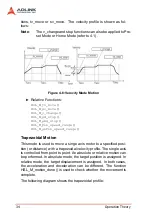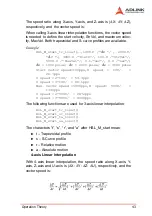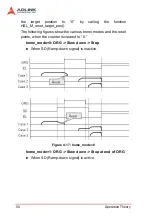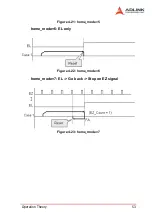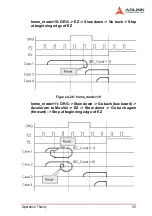
46
Operation Theory
and Axis1, and also Axis3 (Axis0=x, Axis1=y, Axis2=z, Axis3=u).
For the full lists of functions.
To check if the board supports these functions use the
HSL_M_version_info() function. If hardware information for the
card returns a value with the 4th digit greater then 0, for example
'1003', users can use this group of circular interpolation to perform
S or T-curve speed profiles. If the hardware version returns a
value with the 4th digit being 0, then that board does not support
these functions.
Figure 4-14: Circular Interpolation with Acc/dec Time
Relationship between Velocity and Acceleration Time
The maximum velocity parameter of a motion function will eventu-
ally have a minimum acceleration value. This means that there is a
range for acceleration time over one velocity value. Under this
relationship, to obtain a small acceleration time, a higher maxi-
mum velocity value to match the smaller acceleration time is
required. Function HSL_M_fix_speed_range() will provide such
operation. This function will raise the maximum velocity value,
which in turn results in a smaller acceleration time. Note it does
not affect the actual end velocity. For example, to have a 1ms
acceleration time from a velocity of 0 to 5000(pps), the function
can be inserted before the motion function as shown.
HSL_M_fix_speed_range(AxisNo,OverVelocity);
HSL_M_start_tr_move(AxisNo,5000,0,5000,0.001,0.0
01);
Содержание HSL-4XMO
Страница 4: ......
Страница 16: ...6 Introduction ...
Страница 36: ...26 Signal Connections ...
Страница 61: ...Operation Theory 51 Figure 4 18 home_mode 1 home_mode 3 ORG EZ Slow down Stop Figure 4 19 home_mode 3 ...
Страница 67: ...Operation Theory 57 Home Search Example Home mode 1 Figure 4 29 Home Search Example ...
Страница 108: ...98 Motion Creator in LinkMaster ...



